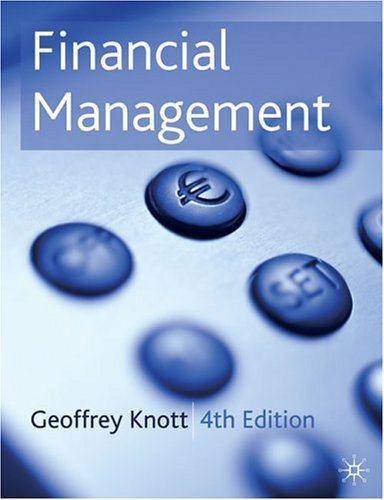Question
The Howe Computer Company has grown rapidly during the past 5 years. Recently, its commercial bank urged the company to consider increasing its permanent financing.
The Howe Computer Company has grown rapidly during the past 5 years. Recently, its commercial bank urged the company to consider increasing its permanent financing. Its bank loan under a line of credit has risen to $150,000, carrying a 10% interest rate, and Howe has been 30 to 60 days late in paying trade creditors.
Discussions with an investment banker have resulted in the decision to raise $250,000 at this time. Investment bankers have assured Howe that the following alternatives are feasible (flotation costs will be ignored):
- Alternative 1: Sell common stock at $10 per share.
- Alternative 2: Sell convertible bonds at a 10% coupon, convertible into 80 shares of common stock for each $1,000 bond (that is, the conversion price is $12.50 per share).
- Alternative 3: Sell debentures with a 10% coupon; each $1,000 bond will have 80 warrants to buy 1 share of common stock at $12.50.
Keith Howe, the president, owns 80% of Howe's common stock and wishes to maintain control of the company; 50,000 shares are outstanding. The following are summaries of Howe's latest financial statements:
| Balance Sheet | ||||
| | ||||
| Current liabilities | $200,000 | |||
| Common stock, $1 par | 50,000 | |||
| Retained earnings | 25,000 | |||
| Total assets | $275,000 | Total liabilities and equity | $275,000 | |
| Income Statement | |||
| | |||
| Sales | $550,000 | ||
| All costs except interest | 495,000 | ||
| EBIT | $55,000 | ||
| Interest | 15,000 | ||
| EBT | $40,000 | ||
| Taxes (40%) | 16,000 | ||
| Net income | $24,000 | ||
| Shares outstanding | 50,000 | ||
| Earnings per share | $0.48 | ||
| Price/earnings ratio | 18x | ||
| Market price of stock | $8.64 | ||
Alternative 1 :
1. Total Current Liabilities $
2. Long-term debt Common stock, par $1 $
3. Paid in Capital $
4. Retained Earning $
5. Total Assets $
6. Total Liabilities and Equity $
Alternative 2:
7. Total Current Liabilities $
8. Long-term debt Common stock, par $1 $
9. Paid in Capital $
10. Retained Earning $
11. Total Assets $
12. Total Liabilities and Equity $
Alternative 3:
13.Total current liabilities $
14.Long-term debt (10%) $
15.Common stock, par $1 $
16.Paid-in capital $
17.Retained earnings $
18.Total assets $
19.Total liabilities and equity $
B. Show Keith Howe's control position under each alternative, assuming that he does not purchase additional shares. Round your answers to two decimal places.
Percent Ownership
Plan 1:
20.
Plan 2:
21.
Plan 3:
22.
C. What is the effect on earnings per share of each alternative if it is assumed that earnings before interest and taxes will be 20% of total assets? Round your answers to two decimal places.
Earning per share
Original
23. $
Plan 1
24. $
Plan 2
25. $
Plan 3
26.
D.What will be the debt ratio under each alternative? Round your answers to two decimal places.
Plan 1 :
27. %
Plan 2 :
28. %
Plan 3 :
29. %
JUST NEED ANSWERS! DON'T NEED DETAILS!
Step by Step Solution
There are 3 Steps involved in it
Step: 1

Get Instant Access to Expert-Tailored Solutions
See step-by-step solutions with expert insights and AI powered tools for academic success
Step: 2

Step: 3

Ace Your Homework with AI
Get the answers you need in no time with our AI-driven, step-by-step assistance
Get Started


